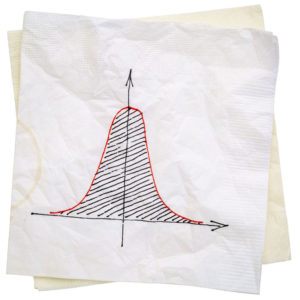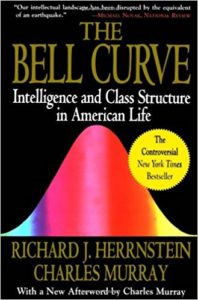Ring a Bell? Charles Murray and the Resurgence of Scientific Racism

In his latest podcast episode titled “Forbidden Knowledge,” atheist author Sam Harris guides political scientist Charles Murray through an extensive defence of Murray’s widely debunked body of work, focusing mostly on The Bell Curve. Co-authored with psychologist Richard Herrnstein (who died around the time it was published in 1994), the book was universally critiqued as an example of modern-day scientific racism.
The Bell Curve was founded on a flawed premise that inferred a correlation between intelligence, socio-economic achievement, and genetics, without accounting for the effects of discrimination. The research was funded by the eugenics-promoting Pioneer Fund, while academics like Stephen Jay Gould showed that The Bell Curve obscured data.
Time has proven the book to be scientifically “reckless.” It enjoys a resurgence in 2017, the era of Trump, specifically because it is read as proof that White people are superior to racial minorities, especially Black and Latin people.
As interviewer and skeptic, Harris evades his responsibilities. Instead, he describes Murray’s critics with emotional language, setting him up as a Galileo figure persecuted by “a silent mob.” Harris describes Murray as a victim of “politically correct moral panic,” “modern witch burning,” “defamation,” and “an anti-free speech hysteria that is spreading on college campuses,” referring to a protest of Murray’s public talk at Middlebury College in Vermont. Harris sums Murray up as “the intellectual treated most unfairly in my lifetime.”
 Murray’s critics are predominantly academics who evaluate The Bell Curve using empirical evidence. Equating the scientific method with moral arguments is problematic.
Murray’s critics are predominantly academics who evaluate The Bell Curve using empirical evidence. Equating the scientific method with moral arguments is problematic.
Among a series of uncritical and scientifically incorrect claims, Harris states:
Genes are “50 to 80 percent of the story” on intelligence. In fact, studies led by Professor Eric Turkheimer show that socioeconomics and genetics interact.
Intelligence is a “taboo topic.” It isn’t; it continues to be widely studied, including in relation to cross-national social inequality.
The Bell Curve’s claims on IQ are “one of the most robust findings in psychology.” Not even close. In a symposium, Professor Robert Hauser shows that the book is “destructive.”
“It was kind of a moral panic when you look at just how irrational the claims were [about The Bell Curve]… that intelligence doesn’t exist.” It isn’t intelligence that’s disputed, it’s how we define, measure, and interpret its impact and influences that varies.
Harris reinforces the notion that The Bell Curve is undisputed fact. Murray acquiesces, making unfounded comments:
“Nothing’s been overturned since The Bell Curve came out”
“If you’re an employer and you can only have one piece of datum, you are better off having an IQ score than you are having an interview, grades, degrees or anything else.”
On refuting claims that SAT and other standardized tests are culturally biased: “The predictability of these studies has been established over and over.”
The critique of Murray’s book centers on “a single solitary paragraph that said… if you’re offended by The Bell Curve, you are obligated to defend that the Black/White difference in IQ scores is 100 percent environmental.”
Murray also says the 1996 American Psychological Association Intelligence Task Force Report vindicated The Bell Curve.
The Task Force report alone refutes all these claims by emphasizing that there are several gaps in the IQ literature. Chief among them is a lack of consensus about how genetic endowment and environmental influence impact intelligence. The report finds that standardized tests are limited in their ability to measure “all forms of intelligence.”
“People I know of, academics especially, who actually read the book had to know that they were lying,” Murray says of his critics. “Because I guess in their own minds they were doing the Lord’s work.”
This is a serious and decidedly unscholarly claim to make, given that the scientific community has continued to disprove The Bell Curve with empirical evidence.
Even though Murray is considered a White nationalist, Harris refutes critiques that Murray’s science is motivated by racial bias, stating: “The man is not Heinrich Himmler.” Instead, Murray is “a deeply rational and careful scholar who is motivated by an ethical concern about inequality in our society. This is not a person who is in favor of discrimination.”
In a familiar trope, Murray uses the example of Barack Obama to deflect racism. He sets up a scenario where Obama walks into an interview:
“You need a really smart guy and Barack Obama walks into the interview. Okay he’s Black. If you then make inferences about how smart he is based on his membership in an ethnic group you are going to be making a huge mistake.”
Later, Murray evokes Obama to argue that “affirmative action” has made it near impossible for employers to hire someone like the 44th President of the United States.
“What social policy is doing in an employer’s mind when it is a Black candidate walking into that office, is all sorts of things that are raising the cost of hiring that person for that employer. Raising the cost in terms of vulnerability to discrimination lawsuits.”
And yet Murray says his writing was motivated by a need to speak out against affirmative action.
“A lot of that is, how would I feel if I were a Black kid my age going into college and everybody thought I was an affirmative action kid? I would hate that. I would really hate it.”
Murray will never know, because White men’s achievements are not restricted by structural racism.
Murray displays what Professor Eduardo Bonilla-Silva calls “racism without racists.” White men like Murray are overly preoccupied with the belief that affirmative action is leading society to ruin, when in fact the biggest beneficiaries of this legislation have been White middle-class women—not racial minorities.
Professor Michael Kimmel shows that White men feel angry that the world they thought they’d inherit, with them still in control, has changed. This “aggrieved entitlement” extends to other White male-dominated spaces, including the atheist movement.
Harris’s characterizations of Murray’s critics are a projection of the push back he feels he’s unfairly faced. “You were one of the canaries in the coal mines,” Harris tells Murray. Having previously dismissed Murray, Harris now feels an affinity due to facing rebuke for racism (while continuing to espouse similar views).
The atheist movement has changed. Once the almost-exclusive domain of White men, calls for equality have challenged conversations, as diverse groups of women and minorities seek a more inclusive vision for atheism. It is telling that aggrieved White men feel more comfortable hosting uncritical discussions on scientific racism than engaging in anti-racism practices to reform the movement.
